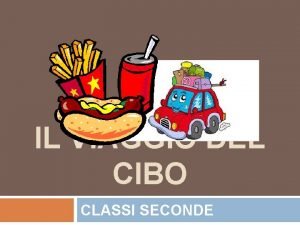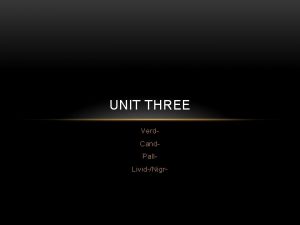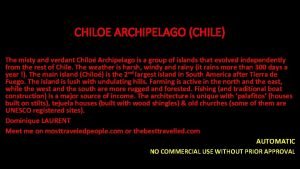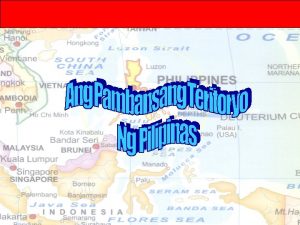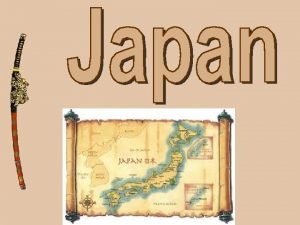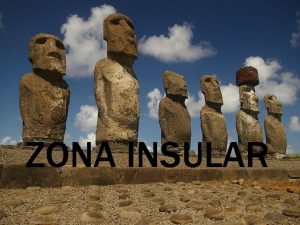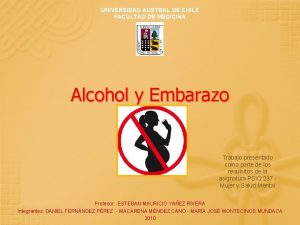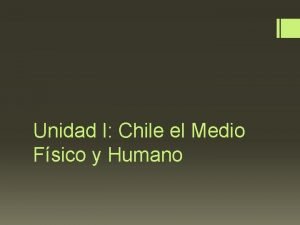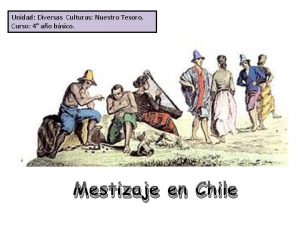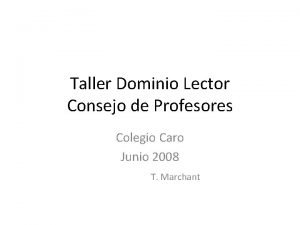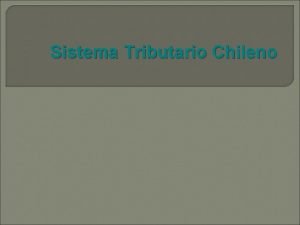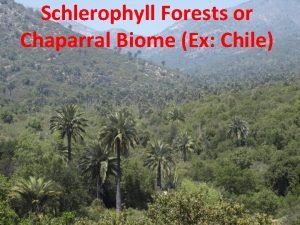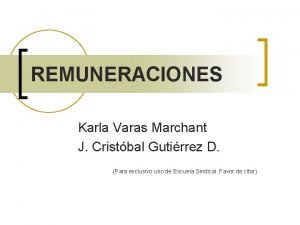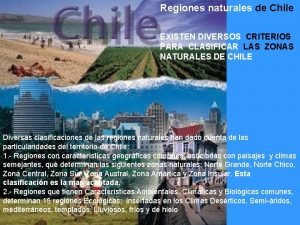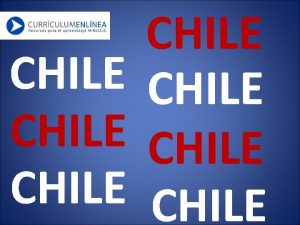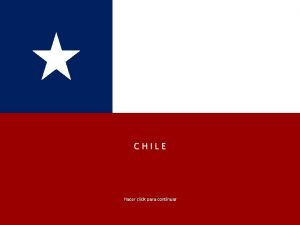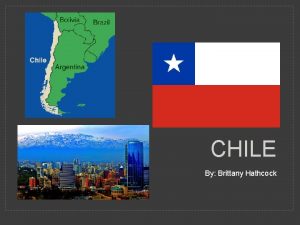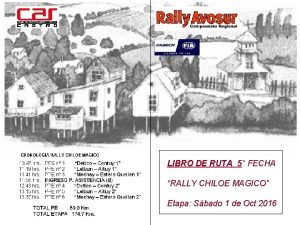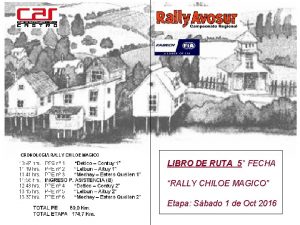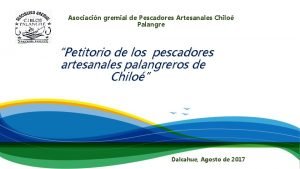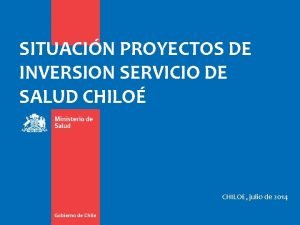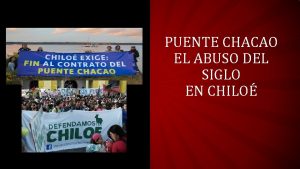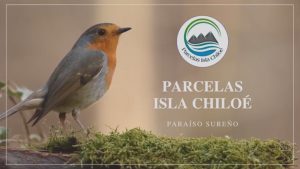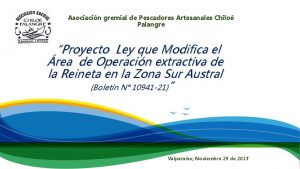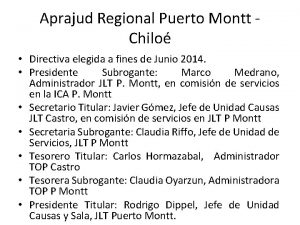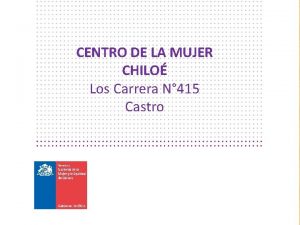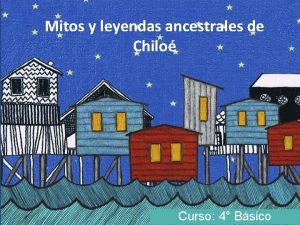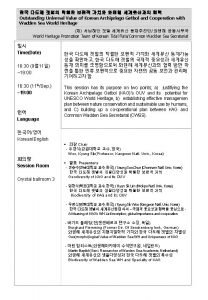CHILOE ARCHIPELAGO CHILE The misty and verdant Chilo






































































- Slides: 70

CHILOE ARCHIPELAGO (CHILE) The misty and verdant Chiloé Archipelago is a group of islands that evolved independently from the rest of Chile. The weather is harsh, windy and rainy (it rains more than 300 days a year !). The main island (Chiloé) is the 2 nd largest island in South America after Tierra de Fuego. The island is lush with undulating hills. Farming is active in the north and the east, while the west and the south are more rugged and forested. Fishing (and traditional boat construction) is a major source of income. The architecture is unique with ‘palafitos’ (houses built on stilts), tejuela houses (built with wood shingles) & old churches (some of them are UNESCO registered sites). Dominique LAURENT Meet me on mosttraveledpeople. com or thebesttravelled. com AUTOMATIC NO COMMERCIAL USE WITHOUT PRIOR APPROVAL

THE ENVIRONMENT

Typical landscape of the eastern half of Chiloé

Near Bahia Cocohue (western coast of Chiloé) The eastern half of Chiloé, a bit more sheltered from bad weather, is much more populated and cultivated than the rugged western side of the island exposed to the strong winds and rains coming from the Pacific.

‘Head’ : strange rock formation (western coast)

<- Seaweed (western coast) Seaweed for sale on a market (Dalcahue) ->

Pinguinera Islotes de Punihuil (islets off Chiloé western coast) A penguin colony : the only one in the world where both Humbolt & Magellan penguins nest side by side.

Birds (pelican. . . ) and a sea otter (off Chiloé western coast)

Cucao beach (western coast), Parque Nacional Chiloé

Parque Nacional Chiloé

<- Gorze flower Medallita (Sarmienta repens) flower -> Parque Nacional Chiloé

Nalca leaves A giant plant species native to southern Chile which can grow up to 2. 5 m across. Parque Nacional Chiloé

Nalca leaves Parque Nacional Chiloé

Nalca leaves Parque Nacional Chiloé

Ferns Parque Nacional Chiloé

Parque Nacional Chiloé

<- Coihüe Tepual-> The ‘coihüe’ (or ‘coigüe’) of Chiloé is a hermaphroditic tree which can grow up to 45 m. Some of the churches and houses of Chiloe are built with wood coming from this tree, along with wood from ‘alerce’. The ‘tepual’ tree is an evergreen tree, with very small leaves, native to southern South America, especially Chiloé and is a typical resident of very wet areas. Parque Nacional Chiloé

This monument at Punta de Lapa (near Quellon) marks the official southern terminus of the Panamerican Highway

The Spaniards took full possession of Chiloé in 1567 and fortified the island with several forts. During the wars of independence, Chiloé was a strong Spanish stronghold. Spain’s last Chilean outposts were : Fuerte San Antonio (above), in Ancud Fuerte Ahui (bottom), also named Castillo San Miguel de Agüi, in Peninsula de Lacuy

PALAFITOS & TEJUELA HOUSES Chiloé is famous for its ‘Palafitos’ : houses mounted on stilts along the water’s edge. Traditional houses and churches are built with ‘tejuelas’ (wood shingles).

‘Palafitos’ (eastern side of Castro) viewed from near Balneario Ten

‘Palafitos’ (northern side of Castro) viewed from Piedrapten

A ‘palafito’ in Quemchi (Casa Francisco Coloane)

Traditional tejuela house, Curaco de Velez (Isla Quinchao))

Traditional tejuela house (Isla Quinchao)

Different types of ‘tejuelas’ (made of patagonian trees (‘alerce’ -a kind of cypress- or ‘coihüe’)

Different types of ‘tejuelas’ made of patagonian trees (‘alerce’ -a kind of cypress- or ‘coihüe’) Hue region This way of building churches and houses was imported in 1862 by the first German settlers in Chiloé who came from the Llanqui. Hhue región (South Chile).

UNESCO REGISTERED CHURCHES The Churches of Chiloé are a unique architectural phenomenon in the Americas. Unlike classical Spanish colonial architecture, the churches of Chiloé are made entirely in native timber with wood shingles (‘tejuelas’). Built in the 18 th & 19 th when Chiloé Archipelago was still a part of the Spanish Crown possessions, the churches represent the fusion of European Jesuit culture and local native peoples' skill and traditions. 16 of the Churches of Chiloé are designated UNESCO World Heritage Sites. Here are 13 of them (3 are missing : Dalcahue which is being restored, Caguach and Chelin in 2 rather remote islands).

Iglesia San Francisco (Castro) the tallest & most elaborate church

Iglesia San Francisco (Castro) at dusk

Iglesia Nuestra Senora de Los Dolores (Nercon)

<- Iglesia Nuestra San Carlos de Borroneo (Chonchi) Iglesia San Antonio (Vilupulli) -> The church with the most delicate and slender tower

<- Iglesia Santa Maria (Rilan) Iglesia Nuestra Senora del Patrocino (Tenaun) > Church with 2 side towers

Iglesia San Juan Bautista (San Juan) Iglesia San Antonio (Colo)

Iglesia Santa Maria de Loreto (Achao, Isla Quinchao) The oldest church (1764).

Iglesia Nuestra Senora de Gracia (Quinchao, Isla Quinchao) the largest church

Iglesia Natividad de Maria (Ichuac, Isla Lemuy)

Iglesia Jesus Nazarino (Aldachilo, Isla Lemuy) The best for its inside paintings

Iglesia Santiago Apostal (Detif, Isla Lemuy)

Iglesia Nuestra Senora de Los Dolores (Nercon) As all the churches, it is built entirely out of wood including the colums despite their marble-look.

Iglesia Santa Maria de Loreto (Achao, Isla Quinchao)

Iglesia San Juan Bautista (San Juan)

Choirstalls, Iglesia San Francisco (Castro) All in wood.

Cupola, Iglesia San Franciso (Castro) All in wood.

Painted ceiling with stars, Iglesia Nuestra San Carlos de Borroneo (Chonchi)

Painted & carved ceiling, Iglesia Santa Maria de Loreto (Achao, Isla Quinchao)

Iglesia Jesus Nazarino (Aldachilo, Isla Lemuy) Painted capital & ceiling (moon, stars, flowers …)

Iglesia San Francisco (Castro) Altar San Miguel Arcángel (left) Close up of the Devil (bottom) San Ignacio (right)

<- Iglesia San Antonio (Vilupulli) Iglesia San Antonio -> (Colo)

OTHER CHURCHES Aside the 16 UNESCO registered churches, Chiloé Archipelago boosts more than 140 other churches. Here are some of the most significant ones.

Capilla del Transito (Quellon Viejo)

Iglesia de Quilquico (Peninsula de Rilan)

A chapel (Peninsula de Rilan)

Iglesia San Antonio (Quemchi)

Traditional tejuela house & Iglesia de San Judas Tadeo (Curaco de Velez, Isla Quinchao)

<- Iglesia Chullec (Isla Quinchao) Iglesia San Javier (Isla Quinchao) ->

Iglesia San Agustin (Isla Lemuy)

BOAT CONSTRUCTION Fishing is a major source of income. Traditional boat construction is still thriving in local ‘astilleros’ (dockyards).

A strange bridge (Chanquin, north of Cucao, western coast)

‘Astillero’ (dockyard), Quellon Viejo

‘Astillero’ (dockyard), Castro

ISLA MECHUQUE The further you venture into Chiloé’s smaller islands, the more it feels as if you've traveled back in time. Isla Mechuque, part of the Islas Chauques, is small but stunning. It is like a mini Chiloé offering all of the larger archipelago's attractions condensed down : tejuela houses, palafitos, astillero, church …

Puente de Mechuque

‘Palafitos’, Isla Mechuque

‘Palafitos’, Isla Mechuque

‘Palafitos’, Isla Mechuque

Traditional tejuela house, Isla Mechuque

Traditional tejuela house, Isla Mechuque

Jesus, church of Mechuque

’Astillero’ (dockyard), Isla Mechuque END
 Bolo chimo chilo
Bolo chimo chilo Lo stomaco trasforma il bolo in una poltiglia detta chilo
Lo stomaco trasforma il bolo in una poltiglia detta chilo How to program verdant thermostat
How to program verdant thermostat Cand root definition
Cand root definition Mechuque
Mechuque Misty novitch
Misty novitch Misty swain
Misty swain There once was a unicorn
There once was a unicorn Misty cozac
Misty cozac Misty douglas
Misty douglas Misty parks
Misty parks Ilang isla ang bumubuo sa pilipinas archipelago
Ilang isla ang bumubuo sa pilipinas archipelago Ringiseido
Ringiseido Japan's feudal system
Japan's feudal system Gulag archipelago
Gulag archipelago Hát kết hợp bộ gõ cơ thể
Hát kết hợp bộ gõ cơ thể Frameset trong html5
Frameset trong html5 Bổ thể
Bổ thể Tỉ lệ cơ thể trẻ em
Tỉ lệ cơ thể trẻ em Chó sói
Chó sói Tư thế worm breton là gì
Tư thế worm breton là gì Hát lên người ơi alleluia
Hát lên người ơi alleluia Các môn thể thao bắt đầu bằng tiếng chạy
Các môn thể thao bắt đầu bằng tiếng chạy Thế nào là hệ số cao nhất
Thế nào là hệ số cao nhất Các châu lục và đại dương trên thế giới
Các châu lục và đại dương trên thế giới Công thức tính thế năng
Công thức tính thế năng Trời xanh đây là của chúng ta thể thơ
Trời xanh đây là của chúng ta thể thơ Cách giải mật thư tọa độ
Cách giải mật thư tọa độ Làm thế nào để 102-1=99
Làm thế nào để 102-1=99 độ dài liên kết
độ dài liên kết Các châu lục và đại dương trên thế giới
Các châu lục và đại dương trên thế giới Thơ thất ngôn tứ tuyệt đường luật
Thơ thất ngôn tứ tuyệt đường luật Quá trình desamine hóa có thể tạo ra
Quá trình desamine hóa có thể tạo ra Một số thể thơ truyền thống
Một số thể thơ truyền thống Cái miệng xinh xinh thế chỉ nói điều hay thôi
Cái miệng xinh xinh thế chỉ nói điều hay thôi Vẽ hình chiếu vuông góc của vật thể sau
Vẽ hình chiếu vuông góc của vật thể sau Thế nào là sự mỏi cơ
Thế nào là sự mỏi cơ đặc điểm cơ thể của người tối cổ
đặc điểm cơ thể của người tối cổ V cc cc
V cc cc Vẽ hình chiếu đứng bằng cạnh của vật thể
Vẽ hình chiếu đứng bằng cạnh của vật thể Fecboak
Fecboak Thẻ vin
Thẻ vin đại từ thay thế
đại từ thay thế điện thế nghỉ
điện thế nghỉ Tư thế ngồi viết
Tư thế ngồi viết Diễn thế sinh thái là
Diễn thế sinh thái là Các loại đột biến cấu trúc nhiễm sắc thể
Các loại đột biến cấu trúc nhiễm sắc thể Thế nào là số nguyên tố
Thế nào là số nguyên tố Tư thế ngồi viết
Tư thế ngồi viết Lời thề hippocrates
Lời thề hippocrates Thiếu nhi thế giới liên hoan
Thiếu nhi thế giới liên hoan ưu thế lai là gì
ưu thế lai là gì Sự nuôi và dạy con của hươu
Sự nuôi và dạy con của hươu Sự nuôi và dạy con của hổ
Sự nuôi và dạy con của hổ Hệ hô hấp
Hệ hô hấp Từ ngữ thể hiện lòng nhân hậu
Từ ngữ thể hiện lòng nhân hậu Thế nào là mạng điện lắp đặt kiểu nổi
Thế nào là mạng điện lắp đặt kiểu nổi Chile y sus zonas naturales
Chile y sus zonas naturales Vocabulario geográfico para niños
Vocabulario geográfico para niños Baile zona insular
Baile zona insular Facies sindrome alcoholico fetal
Facies sindrome alcoholico fetal Espacio aereo de chile
Espacio aereo de chile Mestizaje en chile
Mestizaje en chile Psad 56 chile
Psad 56 chile Digital marking
Digital marking Ecolectura chile
Ecolectura chile Que instituciones administran la tributacion en chile
Que instituciones administran la tributacion en chile Chile biome
Chile biome Cuanto es la gratificacion legal mensual en chile
Cuanto es la gratificacion legal mensual en chile Mapa zona austral de chile
Mapa zona austral de chile Pobreza
Pobreza

